#habalhabal
Explore tagged Tumblr posts
Text
Habal-Habal 🏍️ Filipino Motorcycle Taxis: Not for the faint hearted… When travelling by motorbike how many people could you take? One? Two? If you're travelling Habal-Habal through the Philippines, try ten. #HabalHabal #Philippines #Motorcyle #Taxi
1 note
·
View note
Photo

So, technically speaking, ever since the pandemic broke, I never left the house except that time when I had to work in the office and the latter provided shuttle services. Anyways, this the first time I went out. I was trying to contract the #habalhabal services when I noticed the #edsacarouselbus and some members of the #philippinecoastguard dutifully keeping busses and assisting people .... #motorcycles and #busrides A #gisellescablechannel and #gisellestagram moment (at Family Mart, Mckinley Hills) https://www.instagram.com/p/CWcAZUXBXK_/?utm_medium=tumblr
#habalhabal#edsacarouselbus#philippinecoastguard#motorcycles#busrides#gisellescablechannel#gisellestagram
0 notes
Text
Sirao Garden Cebu



Escape and breath the air of new places


There's no time to be bored in a world as beautiful as this.



"When they look at a beautiful view, most people see their memories not the view". Well, i guess they're right.


Thank's to my love & my forever supportive friend na huli pa sa akto para lang mapicturan ako no? Thank's to her that she introduced this place. Worth it.
From IT Park sumakay kami ng habal-habal 500 pesos going to sirao-temple of leah hanggang pauwi, kasali na dun yung waiting time. Entrance fee is 60php. You can have different view sa loob. Di ko lang pinost lahat dito maybe i'll post it in instagram. Anyway, i really reccommend you guys to ride habalhabal than van or taxi. Kasi the views, and the fresh & cold air feel na feel mo lang. Sobrang daming tourist. Like pipilahan nyo pa bago kayo mkapag picture. But all in all, i really love this place.
30 notes
·
View notes
Video
instagram
Big bike? How about long bike?! #habalhabal https://www.instagram.com/p/Bz8avEHn-Hf/?igshid=16qioq1jf1x5p
0 notes
Photo

The bumpy ride was well-worth it #yolo #busrides #habalhabal (at Hermit's Cove, Aloguinsan)
0 notes
Photo

Habal-Habal 🏍️ Filipino Motorcycle Taxis: Not for the faint hearted… https://www.sandspice.com/habal-habal-filipino-motorcycle-taxis/ When travelling by motorbike how many people could you take? One? Two? If you're travelling Habal-Habal through the Philippines, try ten. #Philippines #Motorcyle #Taxi #HabalHabal
1 note
·
View note
Photo

Wow! OMG! with the kids! will you ride on this #habalhabal will you? 🚲 🚥 (at Casiguran, Aurora)
0 notes
Text
Wherever you go around the world, you’re most likely to use public transport at some point. Once you get to the airport, taxis are normally the best option, especially if you have lots of heavy luggage. However, in most countries around the world – in my experience after 30 years of travelling – public transport is sorely lacking.
Here in the Philippines, it’s a very different story. I’ve travelled to every continent, and covered 132 countries, both as a tourist and a soldier, but in all of that time, there has never been a “public” transport system to match that in the Philippines. That’s not to say it is the same all over the country. There are many remote regions where public transport is not as good, such as remote areas of the provinces where people live miles apart, and riding your carabao (the Philippine domestic water buffalo) is still considered the fastest way to get around.
However, in the area where I live, in the Province of Laguna, public transport is unbelievable. Moreover, it is like that in almost every part of the country where there is a decent population. Everywhere I go around the world, I like to try out the public transport systems. From the rickshaws in India and Thailand (here we call them pedicabs or traysikels) to the dolmuşes of Turkey (a kind of minibus on a set route), I’ve tried them all. However, in none of the countries I have visited could you travel from door to door, on a motorized public transport vehicle, without walking more than a few yards. Here you can, and I will explain how later.
I use public transport here all the time, whether it is a journey north to Ilocos Sur, or a quick trip to bayan (town centre – pronounced buy-an) to get some groceries. After I first came here, I soon discovered that Filipinos drive like no-one else on the planet – with a complete disregard for any other road user, and an “I have the right of way” attitude that makes me want to blow up their car, with them in it! I had a few near misses in the first couple of years, driving the car, my motorbike, and my father-in-law’s traysikel, and finally decided that I was going to give up driving. Road rules are completely ignored, and it is not uncommon to have traffic driving contraflow and blocking the road for oncoming traffic, which they then blame for slowing them down. Safety first – let someone else drive!
Local Transport
So, let’s look at the forms of local transport we have here in the Philippines, and how each one works, both on its own and in conjunction with the other types of public transport.
Taxi
Metered taxis are common in Manila and most major provincial hubs. Flagdown fare starts at around P40, and a 15-minute trip rarely costs more than P150. Airport taxi fares usually start at a minimum of P70, then a per-kilometre charge.

Most taxi drivers will turn on the meter; if they don’t, politely request that they do. If the meter is “broken” or your taxi driver says the fare is “up to you”, the best strategy is to get out and find another cab (or offer a lower price). Rigged meters are also becoming more common, although it must be said that most taxi drivers are honest.
Though it’s not common, there have been cases of taxi passengers being robbed at gun or knife point, sometimes with the driver in cahoots with the culprits or the driver himself holding up the passengers. Get out of a cab straight away (in a secure populated area, of course, not in the middle of nowhere or in a slum area) if you suspect you’re being taken for a ride in more ways than one.
An alternative is to arrange a car and driver for the day – from P2000 to P4000 – through your hotel or another trustworthy source.
Uber
The Uber system of getting a car through an app on your smartphone has had major problems in the Philippines, as the whole concept of using a private vehicle for paying passengers is illegal. The Land Transportation Franchising and Regulatory Board (LTFRB) has put a hold on new drivers, and wants Uber to disassociate themselves from drivers without proper documents.
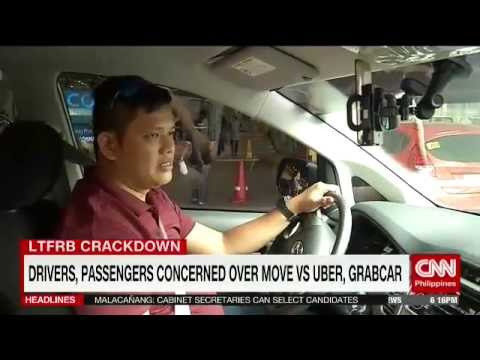
Meanwhile, the Land Transportation Office (LTO) regulations state that in order to carry paying passengers, vehicles must have a commercial license plate, and carry insurance as well as the driver having a professional driving license. Uber drivers being able to continue in the Philippines is as yet uncertain. The costs are not that low either.
Light Rail/Manila Rail
Some parts of Manila are served by an elevated railway system, akin to rapid transit metro. Known locally as LRT-1 (the Green Line that runs north-south) and LRT-2 (the Blue Line that runs east-west), and MRT-3 (the Yellow Line, which runs along the north and south lanes of Epifanio de los Santos Avenue, known locally as EDSA), these three railway lines transport more than 1.25 million passengers a day.
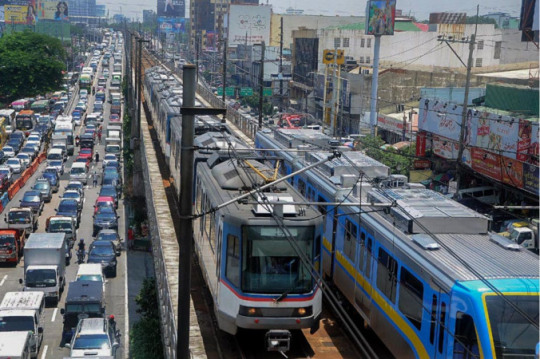
The major benefit of the LRT and MRT lines is the speed at which you can get from one part of Metro Manila to another. With Metro Manila comprising of 16 cities and the municipality of Pateros, this huge metropolis, known collectively as National Capital Region, covers an area of 619.5 km2. To complete the journey along EDSA by bus or car, from south to north, would normally take 4-5 hours, due to the immense volume of traffic.
The main drawback of the LRT and MRT lines is the crowded carriages. No matter what station you get on, chances are you will be standing the entire trip, and crushed up together with hundreds of other commuters.
Jeepney
The first jeepneys were modified army jeeps left behind by the Americans after WWII. They have been customised with Filipino touches such as chrome horses, banks of coloured headlights, radio antennae, paintings of the Virgin Mary and neon-coloured scenes from action comic books, as well as national flags and scenes from different countries, depending on the work location of the Overseas Filipino Worker (OFW) that paid for the jeepney.
Jeepneys form the main urban transport in most cities and complement the bus services between regional centres. The starting fare is usually P8, rising modestly for trips outside the primary distance allowed for that P8 fare. Routes are clearly written on the side of the jeepney, and signs in the windscreen show what locations the jeepney will pass through.
Jeepneys have a certain quirky, cultural appeal, but from a tourist’s perspective, they have one humongous flaw: you can barely see anything through the narrow open slats that pass as windows. The best seats are up front next to the driver.
Again, in most places, jeepneys can fill up fast, especially during rush hours, and sitting cramped with 10 other people on each side of the jeepney is normal. Drivers try to cram as many people in as possible, to get the maximum possible fare, and some passengers are even hanging on to the back, while standing on the step or the rear fender, although this is technically illegal. In more remote areas, it is common for jeepneys to have a roof full of passengers.
I have to say it, jeepneys are one of my favourite forms of public transport here, and I love to commute around the country. Although I can drive, I don’t like to here, and it’s much nicer to let someone else worry about the traffic while we watch the world go by through the small “windows”.
Traysikel
Found in most cities and towns, the traysikel (pronounced try-see-kell) is the Philippine rickshaw – a little, roofed sidecar bolted to a motorcycle. The standard fare for local trips in most provincial towns is P8, which goes up piso by piso the further you get from the pickup point. Traysikels that wait around in front of malls, restaurants and hotels will attempt to charge five to ten times that for a “special” trip, which is like hiring the whole vehicle. Avoid these by standing roadside and flagging down a passing P8 tricycle.
The general rule is, if you flag down a passing traysikel it is single fare only. And they will normally slow down to ask where you are going as they go past. If they don’t, it usually means they are going home or are probably not for hire. Travelling on a traysikel can also be done from a terminal. Just like buses and jeepneys, traysikels have terminals (or should if they are franchised, although some “colorum” traysikels just roam around without the correct plates or licenses picking up passengers along the way). A trip from the terminal, unless you ask for the “special” trip, will cost a single fare.
For example, if I get a traysikel from bayan to the house, it’s P13 if it’s shared. The “special” costs me P52, the price of four normal passengers. Prices can vary from terminal to terminal, so it’s best to always ask the fare before you ride. Traysikels are my other favourite form of public transport here, and the drivers work hard to make enough to feed their families, but they will rarely try and rip you off, even as foreign visitors. If the single fare in your shared traysikel is P8, that’s what you’ll pay.
You can also charter tricycles for about P300 per hour or P150 per 10km if you’re heading out of town.
Pedicabs
Many towns also have non-motorised push tricycles, alternately known as Pedicabs or padyak, for shorter trips. Padyak is a the Tagalog word for stomping or forcefully stepping, which is the action used by the drivers when they are pedaling a pedicab with passengers.
Fares are really cheap, sometimes as much as a few pesos less that traysikels, but they will only go short distances. Many open subdivisions (our kind of housing estate) have Pedicabs at the entrance, as well as dotted around inside, for resident’s convenience.
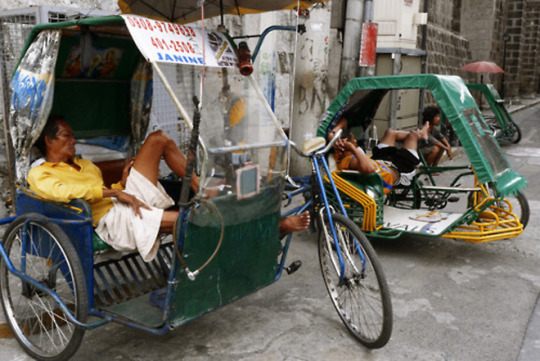
Habal-habal
In the mountain barangays or in the countryside where roads are steep and unpaved, Filipinos always find ways to make things faster and easier to navigate. So, motorcycles are turned into motor-taxis to replace carabaos as a mode of transport.
The normal motorcycle or motorbike is enough only for a passenger and a driver. However, the “habal-habal” motorcycle can carry 2 to 8 passengers (if installed with wooden wings). They are most common in the Visayas and northern Mindanao, although the motorcycle taxi is making inroads in Metro Manila in recent years, just taking only one passenger at a time.
ONLY IN MINDANAO. A motorcycle with 6 passengers ply the Pagalungan highway in Maguindanao province on June 8, 2012 MindaNews photo by Ruby Thursday More
In some areas in the Visayas and Mindanao, “habal-habal” is the term used to call a motorcycle-taxi where the driver and the passengers are in “habal” (animal) position. “Habal” is a Bisayan term that literally means “the sexual (act) intercourse of animals” but now, it seems like the meaning has evolved to mean the mode of transportation… probably due to the “intimate” way passengers are crammed together behind the driver.

Kalesa
A kalesa (also known as caritela or karitela) is a horse-drawn calash used in the Philippines. It was one mode of transportation introduced to the islands in the 18th century by the Spanish, and was initially reserved for only nobles and high-ranking civic officials. These are rarely used in the streets today, except in the tourist-frequented areas of old cities and some rural areas.
A kalesa looks like an inclined cart, and is drawn by a single horse. It has two round wheels on each side and two rows of seats that can accommodate four persons. The driver sits on a block of wood located at the front of the cart near the horse.
Although the kalesa has become a rarity, century-old examples are still preserved in areas of the Philippines, such as in Vigan and Laoag. Kalesas can also be found in Intramuros, where they cater to tourists and Binondo in Manila, as well as in Iligan, where decorated kalesas can be taken for a ride along a specific street. In Cagayan, kalesas are common, especially in Tuao and other municipalities of the province. In Tuguegarao, the carriages are a part of the traffic along with private cars, motorcycles, tricycles, jeepneys, trucks, and bicycles.
Bus & Van
Philippine buses come in all shapes and sizes. Bus depots are dotted throughout towns and the countryside, and most buses will stop if you wave them down. Bus “terminals” also run the gamut. Some are well-secured large garage-like structures with destinations clearly signposted and even ticket booths, whereas others are nothing more than a few run-down outdoor sheds with drivers clamouring for your business. I have even known some locally that are “terminals” in the car park of the local Jollibee or SM Mall.
More services run in the morning – buses on unsealed roads may only run in the morning, especially in remote areas. Night services, including deluxe 27-seaters, are common between Manila and major provincial hubs in Luzon, and in Mindanao.
In NCR, there are normally two kinds of buses. The air-conditioned buses, with closed windows and cool, have their refreshing AC running at close to freezing all the time, while the “ordinary” buses are open, old and amazingly fast. Whereas the AC buses run along the highways almost following the road rules, the “ordinary” buses, which have no air-con except the open windows and rust holes, race along at breathtaking speeds, changing lanes at the drop of a hat, and not slowing down for anyone or anything smaller than them.
While it is nice to ride the AC buses in the hotter weather here, the “ordinary” buses have more character, are cheaper, and often get you there faster, unless it is rush hour in Manila. They look and sound as if they are about to fall apart, but I’ve not ridden on one that has… yet! And when they are going at speed, the open windows give you a cooling breeze, even if it is smog-filled from traffic fumes.
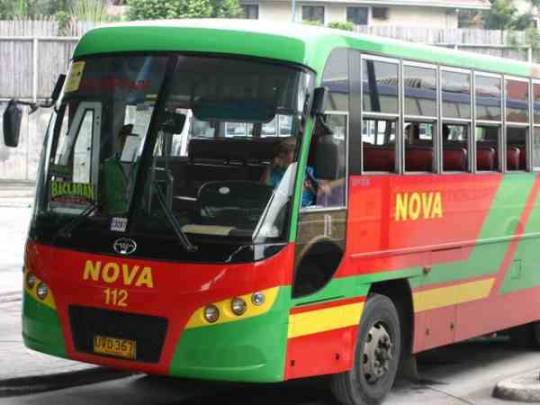
When riding the buses in Manila, especially the “ordinary” ones, be aware of the fares from place to place. It pays to listen to where the people around you are going, to know how much the ride will be, as the conductors will often add a little “surcharge” to foreigners who don’t know the fares. In more than a year of daily trips from Laguna to Makati, I was often told the fare was P10 more than it actually was.
Air-con minivans shadow bus routes in many parts of the Philippines (especially NCR, Bicol, Leyte, Cebu, Palawan and Mindanao) and in some cases have replaced buses altogether. However, you may have to play a waiting game until the vehicles are full. While they are a lot faster, they are not allowed to stop anywhere in Metro Manila, unlike the jeepneys, and there are many that are run illegally, with private use plates instead of commercial plates.
Door-to-door Service
As I mentioned earlier, the Philippines is the only place I know where you can go door-to-door without walking more than a few yards. And I said I would explain how, so here it is.
The best example is going from my house, inside a subdivision, to my wife’s tita (aunt) who lives in Parañaque, Metro Manila.
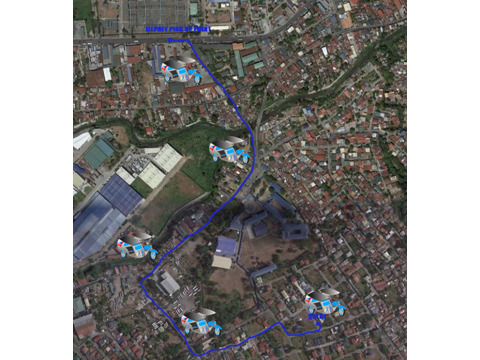
From my house, I can get a traysikel just outside the house to the main highway. Since I live inside a subdivision, a little village of sorts inside the city limits, traysikels often drop passengers off inside, and then go back out. Since they are often not part of the TODA (Traysikel Operators and Drivers Association) for that subdivision or barangay, they cannot go to the nearest terminal, and will pick up roadside passengers along the way, to maximize their income for the trip.
From where I get dropped on the highway, I can get a jeepney across the road to take me to Alabang, in Muntinlupa, which drops off inside Starmall.

The terminal for the buses going all over NCR is right outside, and I can get on one that says “Ayala Ibabaw” on the signs in the windscreen. Conductors are always touting for passengers, and will help with which bus you need to take for people who are not sure.
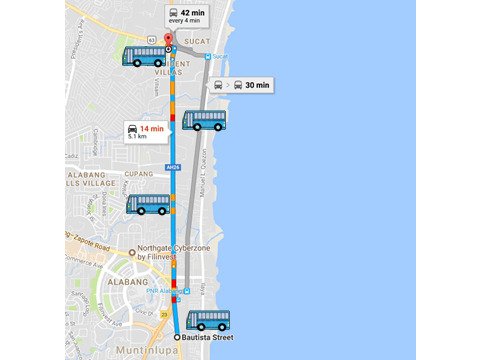
The bus route takes me all the way to Parañaque along SLEX (South Luzon Expressway) and Metro Manila Skyway, and drops off at the Sucat exit.

Cross the road, and I get a jeepney going to San Isidro, which is a single fare price of P8. Get down from the jeepney at the BPI Bank at Greenheights Ave, and cross the road, to the compound where my wife’s tita lives.
The return journey is much the same. A jeepney going past the road outside the compound will take me back down to the Sucat exit, where I can jump on the first bus back to San Pedro, Laguna. Both AC and “ordinary” buses run the route, and there are hundreds of them going that way looking for passengers. (Alternatively, I can get the bus back to Starmall, and do the journey exactly backwards, but I prefer to get a bus all the way to San Pedro.)
At San Pedro, a jeepney passing by can take me into bayan, and drops off around 20 yards from the traysikel terminal for my subdivision. Another P8 fare for this part of the trip.
From the terminal in bayan, the traysikel takes me back to the subdivision, as a shared ride for only P13, and I can direct the driver on which turns to take to get to my house, though since most of them know me from the terminal, I often don’t need to direct them.
What about the other passengers in the traysikel? Well, it’s the norm here for traysikels to carry rideshare passengers (see, we had rideshare and pool vehicles years before Uber!), and there is a courtesy to let the closest one out first, even if it means travelling through many streets to get to your own house after dropping them off.
Another thing that we have with the traysikels is service. Traysikel drivers are some of the nicest people you can meet here, and will gladly carry your shopping bags and sacks of rice to your door, and even inside (if you don’t have nasty, biting dogs like I have), for no extra charge.
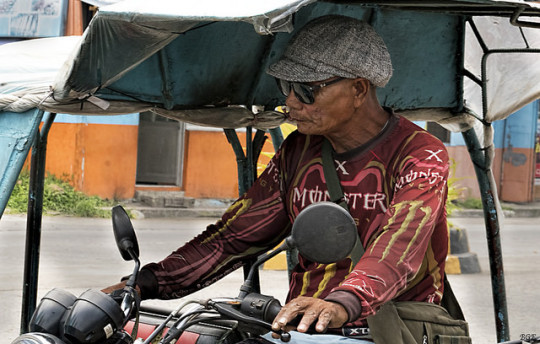
So, if you are thinking of coming to the Philippines, try to travel on the local public transport, and experience commuting the Filipino way. It really is “More Fun in the Philippines”.
Travel in the Philippines – Commuting like a Local Wherever you go around the world, you’re most likely to use public transport at some point. Once you get to the airport, taxis are normally the best option, especially if you have lots of heavy luggage.
#bus#calash#caritela#dolmus#door-to-door#habalhabal#jeep#jeepney#kalesa#karitela#LRT#MRT#ordinary#padyak#pedicab#Philippines#rail#taxi#travel#traysikel#tricycle#uber#UVExpress#van
0 notes
Photo

“Since there are no tourists yet visiting our place, we go back to our usual job as habal-habal drivers because it is the mode of transportation in Lake Sebu. We also look for other means to earn an income. In my case, I sell fish and vegetables in our local market," Jorie Untang Sabal said, the president of the Tourist Drivers and Local Guides of Lake Sebu. ______ Excerpt from "Region 12 tourism copes with the pandemic" feature story. Link in bio. ______ #Yaduing #SOXtourism #tourism #LakeSebu #SouthCotabato #travelphilippines #travelstories #travelph #interview #people #bnwdocumentary #bnwphotography #bnw_globe #bnw_igers #bnw_of_our_world #bnwportrait #habalhabal (at Lake Sebu, South Cotabato) https://www.instagram.com/p/CG9rWBOnU-x/?igshid=1wdwp5q4oqwt2
#yaduing#soxtourism#tourism#lakesebu#southcotabato#travelphilippines#travelstories#travelph#interview#people#bnwdocumentary#bnwphotography#bnw_globe#bnw_igers#bnw_of_our_world#bnwportrait#habalhabal
0 notes
Photo

Enjoyed our #habalHabal and our failed sunset. And that one peso cake, ending with the jeepney ride, was just epic! 😍 #crateCafe #tazzaCafe #whereToCebu https://www.instagram.com/p/BxwYJLvgFPT/?igshid=1498yhdhqxio6
0 notes
Photo

"Urban Bustle In Layers" #street #streetphotography #mobilephonephotography #iphone5 #tabunoktalisaycitycebu #tricycle #habalhabal #flyover #interchange (at Tabunok Public Market)
#tricycle#interchange#tabunoktalisaycitycebu#iphone5#habalhabal#streetphotography#flyover#street#mobilephonephotography
0 notes
Video
Commuting 🏍 More fun in the Philippines 🇵🇭 . . . #HabalHabal #SquadGoals (at Brgy. Tuno, Tibiao, Antique)
0 notes
Photo

Worth the tan for a day full of fun🏝🏜✌👌 #HabalHabal #IslandHopping #SummerLookBook2017 #Instagrammables #WeekendWarriors #WhenInJomalig #JomaligIslandChallenge (at Jomalig Island)
#habalhabal#instagrammables#jomaligislandchallenge#wheninjomalig#islandhopping#summerlookbook2017#weekendwarriors
0 notes
Photo
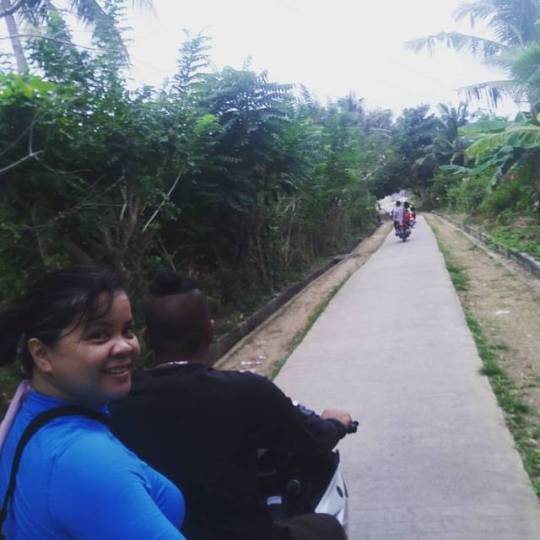
Best way to tour the island is with #HabalHabal especially if you are traveling with friends. #IslaGigantes #LakwatsaNiElda #ElleAndGraceTravelDiary #TravelNiEldaAtGrace
0 notes